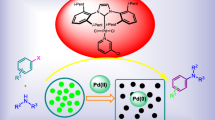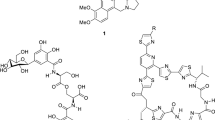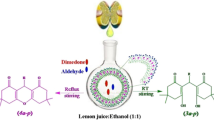Abstract
A simple approach for the synthesis of spiroacenaphthylene-pyranopyrazole derivatives was achieved via the reaction between acenaphthoquinone, pyrazolones, and activated methylene compounds (malononitrile derivatives) in water as a green solvent without using any catalyst in order to avoid the use of transition metal. This method has the advantages of mild reaction condition, short reaction time, easy workup, excellent yields, and avoidance of environmentally hazardous solvents.
Graphic abstract





Similar content being viewed by others
References
Toure BB, Hall DG (2009) Natural product synthesis using multicomponent reaction strategies. Chem Rev 2009:4439–4486. https://doi.org/10.1021/cr800296p
Chebanov VA, Gura KA, Desenko SM (2010) Aminoazoles as key reagents in multicomponent heterocyclizations. Heterocycl Chem 2010:41–84. https://doi.org/10.1007/7081_2009_21
Kumaravel K, Vasuki G (2009) Multi-component reactions in water. Curr Org Chem 2009:1820–1841. https://doi.org/10.2174/138527209789630514
Domling A, Wang W, Wang K (2012) Chemistry and biology of multicomponent reactions. Chem Rev 2012:3083–3135. https://doi.org/10.1021/cr100233r
Yavari M, Khajeh-Khezri A, Bahemmat S, Halvagar MR (2017) A synthesis of novel dioxapropellanes from the knoevenagel adducts of acenaphthoquinone and 3-oxo-3-arylpropionitriles in aqueous methanol. Synlett 2017:1785–1788. https://doi.org/10.1055/s-0036-1588822
Orru RVA, Greef M (2003) Recent advances in solution phase multicomponent methodology for the synthesis of heterocyclic compounds. Synthesis 2003:1471–1499. https://doi.org/10.1055/s-2003-40507
Domling A (2006) Recent developments in isocyanide based multicomponent reactions in applied chemistry. Chem Rev 2006:17–89. https://doi.org/10.1021/cr0505728
Evans GRJM, Vong AK (1995) Pyrans and their benzo derivatives synthesis. In: Katritzky AR, Rees CW, Scriven EFV (eds) Comprehensive heterocyclic chemistry II, vol 469. Pergamon Press, Oxford
Abdelrazek FM, Metz P, Kataeva O, Jager A, El-Mahrouky SF (2007) Synthesis and molluscicidal activity of new chromene and pyrano[2,3-c]pyrazole derivatives. Arch Pharm 2007:543–548. https://doi.org/10.1002/ardp.200700157
Bonsignore L, Loy G, Secci D, Calignano A (1993) Synthesis and pharmacological activity of 2-oxo-(2H) 1-benzopyran-3-carboxamide derivatives. Eur J Med Chem 1993:517–520. https://doi.org/10.1016/0223-5234(93)90020-F
Wu JYC, Fong WF, Zhang JX, Leung CH, Kwong HL, Yang MS, Li D, Cheung HY (2003) Reversal of multidrug resistance in cancer cells by pyranocoumarins isolated from radix peucedani. Eur J Pharmacol 2003:9–17. https://doi.org/10.1016/0223-5234(93)90020-F
Raj T, Bhatia RK, Kapur A, Sharma M, Saxena AK, Ishar MPS (2010) Cytotoxic activity of 3-(5-phenyl-3H-[1,2,4]dithiazol-3-yl)chromen-4-ones and 4-oxo-4H-chromene-3-carbothioic acid N-phenylamides. Eur J Med Chem 2010:790–794. https://doi.org/10.1016/j.ejmech.2009.11.001
Rueping M, Sugiono E, Merino E (2008) Asymmetric organocatalysis: an efficient enantioselective access to benzopyranes and chromenes. Chem Eur J 2008:6329–6332. https://doi.org/10.1002/chem.200800836
Flavin MT, Rizzo JD, Khilevich A, Kucherenko A, Sheinkman AK, Vilaychack V, Lin L, Chen W, Greenwood EM, Pengsuparp T, Pezzuto JM, Hughes SH, Flavin TM, Cibulski M, Boulanger WA, Shone RL, Xu ZQ (1996) Synthesis, chromatographic resolution, and anti-human immunodeficiency virus activity of (±)-calanolide A and its enantiomers. J Med Chem 1996:1303–1313. https://doi.org/10.1021/jm950797i
Moon DO, Kim KC, Jin CY, Han MH, Park C, Lee KJ, Park YM, Choi YH, Kim GY (2007) Inhibitory effects of eicosapentaenoic acid on lipopolysaccharide-induced activation in BV2 microglia. Int Immunopharmacol 2007:222–229. https://doi.org/10.1016/j.intimp.2006.10.001
De Andrade-Neto VF, Goulart MOF, Da Silva Filho JF, Da Silva MJ, Pinto MDCFR, Pinto AV, Zalis MG, Carvalho LH, Krettli AU (2004) Antimalarial activity of phenazines from lapachol, beta-lapachone and its derivatives against plasmodium falciparum in vitro and plasmodium berghei in vivo. Bioorg Med Chem Lett 2004:1145–1149. https://doi.org/10.1016/j.bmcl.2003.12.069
Elisa PS, Ana EB, Ravelo AG, Yapu DJ, Turba AG (2005) Antiplasmodial activity of naphthoquinones related to lapachol and β-lapachone. Chem Biodivers 2005:264–274. https://doi.org/10.1002/cbdv.200590009
Morgan LR, Jursic BS, Hooper CL, Neumann DM, Thangaraj K, Leblance B (2002) Anticancer activity for 4,4′-dihydroxybenzophenone-2,4-dinitrophenylhydrazone (A-007) analogues and their abilities to interact with lymphoendothelial cell surface markers. Bioorg Med Chem Lett 2002:3407–3411. https://doi.org/10.1016/S0960-894X(02)00725-4
Zhang YL, Chen BZ, Zheng KQ, Xu ML, Lei XH, Yaoxue XB (1982) Recent developments in acenaphthoquinone-based multicomponent reactions: synthesis of spiroacenaphthylene compounds. Chem Abstr 1982:135–383. https://doi.org/10.1007/s41061-018-0204-5
Lei M, Ma L, Hu L (2011) A green, efficient, and rapid procedure for the synthesis of 2-amino-3-cyano-1,4,5,6-tetrahydropyrano[3,2-c]quinolin-5-one derivatives catalyzed by ammonium acetate. Tetrahedron Lett 2011:2597–2600. https://doi.org/10.1016/j.tetlet.2011.03.061
Fattah AH, Hesien AM, Metwally SA, Elnagdi MH (1989) The reaction of ethyl 6-amino-5-cyano-4-aryl-2-methyl-4H-pyran-3-carboxylate with nucleophilic reagents. Liebigs Ann Chem 1989:585–588. https://doi.org/10.1002/jlac.1989198901102
Quintela JM, Peinador C, Moreira MJ (1995) A novel synthesis of pyrano[2,3-d]pyrimidine derivatives. Tetrahedron 1995:5901–5912. https://doi.org/10.1016/0040-4020(95)00258-A
Armetso D, Horspool WM, Martin N, Ramos A, Seaone C (1989) Synthesis of cyclobutenes by the novel photochemical ring contraction of 4-substituted 2-amino-3,5 dicyano-6-phenyl-4H-pyrans. J Org Chem 1989:3069–3072. https://doi.org/10.1021/jo00274a021
Kemnitzer W, Drewe J, Jiang S, Zhang H, Zhao J, Crogan-Grundy C, Xu L, Lamothe S, Gourdeau H, Denis R, Tseng B, Kasibhatla S, Cai SX (2007) Discovery of 4-aryl 4H-chromenes as a new series of apoptosis inducers using a cell- and caspase-based high throughput screening assay structure-activity relationships of fused rings at the 7,8 positions. J Med Chem 2007:2858–2864. https://doi.org/10.1021/jm070216c
Himly M, Jahn-Schmid B, Pittertschatscher K, Bohle B, Grubmayr K, Ferreira F, Ebner H, Ebner C (2003) Ige-mediated immediate-type hypersensitivity to the pyrazolone drug propyphenazone. J Allergy Clin Immunol 2003:882–888. https://doi.org/10.1067/mai.2003.163
Fevig JM, Cacciola J, Buriak J, Rossi KA, Knabb RM, Luettgen JM, Wong PC, Bai SA, Wexler RR, Lam PYS (2006) Preparation of 1-(4-methoxyphenyl)-1H-pyrazolo[4,3-d]pyrimidin-7(6H)-ones as potent, selective and bioavailable inhibitors of coagulation factor Xa. Bioorg Med Chem Lett 2006:3755–3760. https://doi.org/10.1016/j.bmcl.2006.04.044
Daniele C, Alessandro DL, Marco R, Beatrice B, Fabrizi M, Matteo M, Sibilla S, Rita M, Lorenza C, Maurizio B (2008) Synthesis, biological evaluation and SAR study of novel pyrazole analogues as inhibitors of mycobacterium tuberculosis. Bioorg Med Chem 2008:8587–8591. https://doi.org/10.1016/j.bmc.2008.08.016
Ahmed K, Dubey B, Nadeem S, Shrivastava B, Sharma P (2016) p-TSA-catalyzed one-pot synthesis and docking studies of some 5H-indeno[1,2-b]quinoline-9,11(6H,10H)-dione derivatives as anticonvulsant agents. Chin Chem Lett 2016:714–720. https://doi.org/10.1016/j.cclet.2016.01.053
Dabiri M, Bahramnejad M, Baghbanzadeh M (2009) Ammonium salt catalyzed multicomponent transformation: simple route to functionalized spirochromenes and spiroacridines. Tetrahedron 2009:9443–9447. https://doi.org/10.1016/j.tet.2009.08.070
Elinson MN, Ilovaisky AI, Merkulova VM, Belyakov PA, Barba F, Batanero B (2012) General non-catalytic approach to spiroacenaphthylene heterocycles: multicomponent assembling of acenaphthenequinone, cyclic CH-acids and malononitrile. Tetrahedron 2012:5833–5837. https://doi.org/10.1016/j.tet.2012.05.005
Author information
Authors and Affiliations
Corresponding author
Additional information
Publisher's Note
Springer Nature remains neutral with regard to jurisdictional claims in published maps and institutional affiliations.
Electronic supplementary material
Below is the link to the electronic supplementary material.
Rights and permissions
About this article
Cite this article
Amiri, Z., Bayat, M. A catalyst-free approach to synthesis of spiroacenaphthylene-pyranopyrazole derivatives in water media. Mol Divers 25, 121–129 (2021). https://doi.org/10.1007/s11030-019-10030-z
Received:
Accepted:
Published:
Issue Date:
DOI: https://doi.org/10.1007/s11030-019-10030-z




